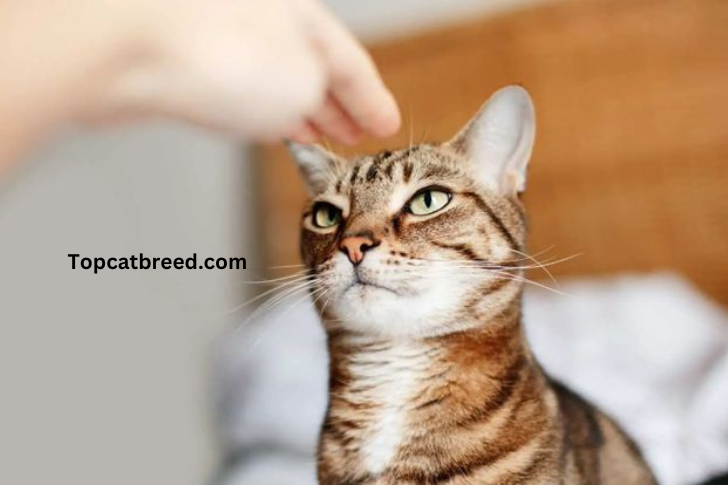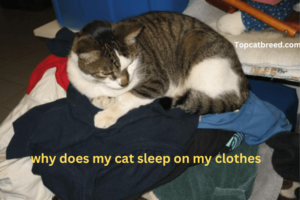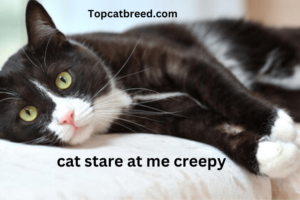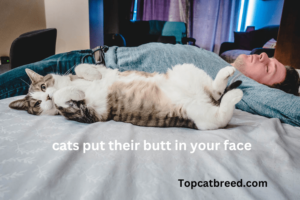Cats, our mysterious and loved feline partners, have a way of capturing our hearts with their distinct behaviors. However, our cats sometimes show surprising emotions, such as flinching when we reach out to pet them. This peculiar behavior leaves many cat owners pondering the reasons behind it. What causes this reaction in our otherwise affectionate pets, and how should we respond to it? In this comprehensive exploration of “Why Does My Cat Flinch When I Touch Her? Reasons,” we will explore the diverse factors that may lead a cat to flinch when touched, as well as the fascinating realm of feline behavior.
We’ll explore into the secrets behind your feline friend’s flinching habits, from their unique personalities to their previous experiences. Understanding the reasons behind your cat’s behavior improves the link between you and your feline buddy, creating an environment in which they feel safe and loved. Embark on this enlightening journey with us to unravel the mysteries of “why does my cat flinch when I touch her,” gaining insights into the subtle messages our cats may be conveying during these interactions.. By delving into these insights, we can foster a deeper connection and create a more enriching relationship with our beloved pets.
Why Do Cats Flinch?
Cats have always intrigued us with their unique and often baffling behavior. One such perplexing action is when your cat unexpectedly flinches at your touch. While it might seem like a mystery, this behavior is not without reason. To unravel the underlying motives for this response, let’s embark on a journey into the complex world of feline behavior.
Cats exhibit a complex interplay of instincts, experiences, and personality traits. Each cat is a unique individual, and their behavior is a result of this intricate blend. Understanding why some cats flinch when touched requires a deeper exploration of their minds and bodies. By examining the sensitive areas on their bodies, their past experiences, and their inherent personalities, we can demystify this unique behavior and strengthen our bond with these captivating creatures.
Sensitive Spots on a Cat’s Body
Cats have specific areas on their bodies that are exceptionally sensitive. Understanding these touchy spots is vital to comprehending why cats flinch when touched.
Whisker Area: The area around a cat’s whiskers is highly sensitive. Touching or stroking this region may lead to a flinching response. Tail Base: Many cats are sensitive around the base of their tails. This area should be approached with caution during petting. Belly: While some cats enjoy belly rubs, many find it extremely sensitive. It’s essential to respect your cat’s preferences when it comes to belly touches.
Past Experiences and Their Influence
A cat’s past experiences significantly shape their behavior, including their reactions to touch. Traumatic encounters can instill fear and discomfort, causing cats to flinch even during gentle petting.
Rescue Cats: Cats that have been rescued from abusive or neglectful situations may be more prone to flinching due to their past traumas. Kitten hood Experiences: Early life experiences, especially during the critical socialization period (between two and seven weeks old), play a pivotal role in how a cat perceives touch.
Personality Traits and Their Role
Every cat has a unique personality, affecting how they respond to touch. Recognizing your cat’s inherent traits can provide insights into their flinching behavior. Some cats are naturally more reserved and cautious, while others are outgoing and receptive to touch.
Introverted Cats: Shy or introverted cats may exhibit a tendency to flinch more readily, given their heightened sensitivity to their surroundings. Understanding and respecting their inclination for a gentler approach can contribute to a more positive and reassuring relationship.
Extroverted Cats: Cats that are outgoing and extroverted generally feel more at ease with human touch.
Recognizing these aspects of your cat’s personality enables you to customize your interactions, fostering an environment where they feel comfortable and content.
ALSO READ. Why does my cat meow when I touch her? Reasons
Feline Hyperesthesia Could Be the Cause of Your Cat’s Flinching
Deciphering Feline Hyperesthesia
Feline hyperesthesia is a condition that leads to heightened skin sensitivity, contributing to unusual reactions to touch. Explore the enigmatic world of this ailment to understand its potential role in your cat’s flinching behavior.
Symptoms: Feline hyperesthesia may manifest through symptoms like rippling skin, excessive grooming, and sudden episodes of aggression or frantic behavior.
Diagnosis: Accurate diagnosis of feline hyperesthesia often involves ruling out other potential causes of discomfort through physical examinations and laboratory tests.
Genetic and Environmental Factors
The development of feline hyperesthesia is a blend of genetic predisposition and environmental influences. Investigating these elements can illuminate why certain cats may be more susceptible to this condition.
Genetic Predisposition: Some cat breeds may have a higher genetic predisposition to feline hyperesthesia.
Environmental Stressors: Environmental factors like a stressful living environment can exacerbate the symptoms of feline hyperesthesia.
Understanding the interplay between genetics and environment is crucial in solving the mystery of your cat’s sensitivity.
Treatment of Feline Hyperesthesia
Minimizing Stressors in the Environment
Identifying and minimizing stressors in your cat’s environment is a fundamental step in addressing feline hyperesthesia. Creating a calm and secure atmosphere can significantly improve your cat’s comfort. Safe Spaces: Designate safe spaces in your home where your cat can retreat when they need solitude Routine and Predictability: Establishing a consistent daily routine can provide a sense of security for your cat.
Behavior Modification Strategies
Working with feline behavior experts, you can employ behavior modification techniques aimed at reducing reactivity in cats with feline hyperesthesia. These strategies foster a sense of safety and relaxation.
Positive Reinforcement: Reward-based training methods can help your cat associate positive experiences with touch. Desensitization: Gradual and controlled exposure to touch can help your cat become more comfortable with human interaction.
Medications for Symptom Management
In certain cases, medication may be recommended to manage the symptoms of feline hyperesthesia. These medications can help alleviate the intensity of your cat’s condition, enhancing their overall well-being.
Ant anxiety Medications: Medications like fluoxetine may be prescribed to reduce anxiety and stress in affected cats. Pain Management: Certain cats may find relief from discomfort related to feline hyperesthesia through the use of pain management medications. It is crucial to consult with a veterinarian or a feline behavior specialist to develop the most suitable treatment plan tailored to your cat’s specific needs.
Is It Normal for Cats to Flinch When You Touch Them?
Cats are enigmatic creatures, each with their distinct personalities and quirks. When it comes to their reactions to touch, it can vary significantly. So, is it normal for cats to flinch when touched? The answer lies in understanding the nuances of feline behavior.
Personality Variations
Just like humans, cats have their unique temperaments. While some cats are extremely affectionate and comfortable with being touched, others can be more reserved and sensitive. A flinch now and then from such cats might be considered within the spectrum of normal behavior.
Sometimes, when a cat is caught off guard or receives unexpected touch, they may reflexively flinch. These reactions can be akin to a human jumping when someone suddenly taps their shoulder. In these cases, flinching doesn’t necessarily indicate distress.
Building Trust
Cats, particularly those with reserved personalities, may need time to build trust with their human companions. Flinching could be an initial response, and as trust develops, cats may become more at ease with being touched.
Persistent Flinching
While some occasional flinching is normal, persistent or extreme flinching could indicate underlying issues. Past trauma, abuse, or physical discomfort might be causing your cat’s heightened sensitivity to touch. In such cases, it’s crucial to observe and address the cause of their flinching.
- Flinching when touched is a common response in cats.
- Cats vary in their sensitivity to touch, and it’s not unusual for some to flinch occasionally.
- Cats that have experienced abuse or mistreatment in the past may be more prone to flinching.
- A cat’s age and overall health can influence their sensitivity to touch.
What Does It Mean When Your Cat Is Flinching?
When your cat flinches, it’s essential to interpret the underlying message. Flinching can have various implications, and understanding them is crucial for providing the right care and support.
Discomfort or Pain :If your cat exhibits a flinching response to touch, it could signal potential physical discomfort or pain in a specific part of their body. Paying close attention to their reactions allows for the identification of underlying issues, warranting a thorough veterinary examination to address and alleviate any potential health concerns.
Past Negative Experiences: Flinching can be a result of past negative encounters, such as abuse or mistreatment. If your cat associates touch with adverse experiences, they may flinch as a protective mechanism. Patience, gentleness, and a safe environment are essential for rehabilitating such cats.
- Flinching can have various meanings in cats.
- Past traumatic experiences can make cats more sensitive and prone to flinching.
- Fear or anxiety may lead to apprehension during human contact.
- It may indicate discomfort or pain in a particular area of their body.
Why Does My Cat Jump Every Time I Touch Him?
Cats, with their agile and graceful demeanor, can sometimes exhibit sudden movements, like jumping, when touched.
Touch Sensitivity: Certain cats are inherently more touch sensitive than others. Their heightened sensitivity can cause them to react strongly, such as jumping, when touched. This response isn’t necessarily a sign of discomfort but reflects their unique temperament.
Playful Nature: Cats, especially kittens and younger felines, are inherently playful creatures. Their boundless energy and curiosity can result in playful leaps when touched. For them, it might be an extension of their playful behavior.
Alertness: Cats are known for their exceptional alertness. When you touch a cat that is fully engaged in another activity or is in a highly vigilant state, it’s not uncommon for them to startle and jump. Their keen senses make them react swiftly to unexpected stimuli.
Understanding your cat’s individual disposition and the context of their reactions to touch is crucial for nurturing a harmonious relationship. Patience, gentle interactions, and learning your cat’s preferences will pave the way for a stronger bond.
- Cats may jump or react dramatically to touch for several reasons.
- Extreme touch sensitivity can lead to a jump response, especially if the touch is unexpected.
- Kittens and younger cats are often more excitable and playful, which can result in jumping.
- Cats are easily startled, and sudden touches can trigger a reflexive jump.
- Cats deeply engrossed in other activities may respond dramatically to touch.
Common Mistakes to Avoid When Petting Your Cat
Sudden Movements
Sudden or fast movements while petting can startle your cat. It’s important to be gentle and slow in your gestures to help your cat feel safe and relaxed . Ignoring Their Signals: Cats communicate through body language. If your cat shows signs of discomfort, such as tail flicking or ear flattening, it’s crucial to pay attention and pause or stop petting.
Sensitive Areas
Avoid touching sensitive areas like the belly, paws, and tail base unless you know your cat enjoys it. Many cats prefer being petted on their head, chin, or along the back. Consistency and Routine Establish a routine for petting your cat. Consistent petting sessions help build trust and provide a sense of security for your feline friend.
Consulting a Veterinarian
If your cat consistently flinches or reacts negatively to petting, it’s wise to consult a veterinarian. There might be underlying medical issues causing discomfort. Noise and Environment Cats can be sensitive to noisy or chaotic environments. Try to create a calm and quiet space for petting sessions to minimize stress. Providing a Safe Space Sometimes, cats need alone time. Ensure your cat has a safe and quiet retreat where they can go when they want to be alone.
Avoiding these common mistakes when petting your cat can lead to more positive interactions and a happier, less jumpy feline companion.In this we gave u all details about Why does my cat flinch when I touch her.
FAQS
1: Why does my cat flinch when I touch her?
Cats may flinch due to past abuse, sensitive areas being touched, or their natural temperament.
2: Is it normal for cats to flinch when you touch them?
Flinching can be normal, depending on a cat’s past experiences and personality.
3: What does it mean when your cat is flinching?
Flinching can indicate discomfort or fear, requiring you to be attentive to your cat’s cues.
4: Why does my cat jump every time I touch him?
Cats can startle easily, and unexpected touch may lead to jumping reactions.
5-How can I make my cat more comfortable with petting?
Make your cat comfortable by gentle, preferred area petting, avoiding sensitive spots, providing a quiet environment, and consulting a vet if needed.
conclusion
In conclusion, comprehending the reasons behind Why does my cat flinch when I touch her response to touch is crucial for nurturing a harmonious and positive connection with your furry companion. Each cat’s reaction is shaped by its individual history, personality traits, and sensitivity levels. To establish a comfortable and enjoyable petting routine, it’s important to be attuned to their preferences and to respect their personal boundaries. Recognizing the uniqueness of each cat, patience, and affection play pivotal roles in building trust and providing a sense of safety and security for your beloved feline friend.




